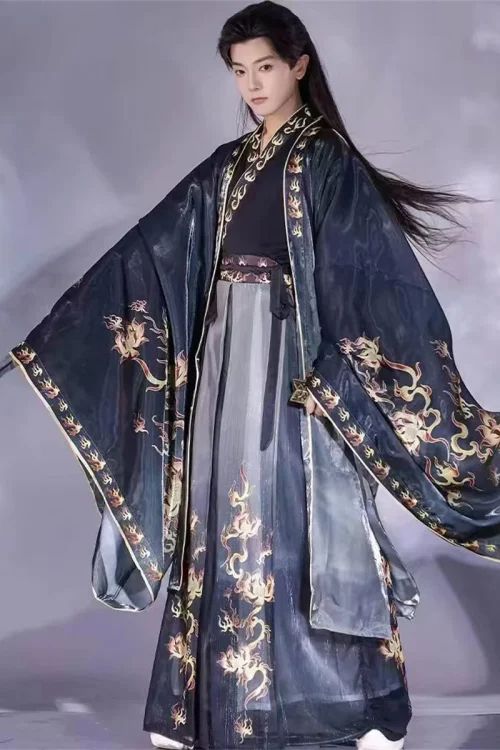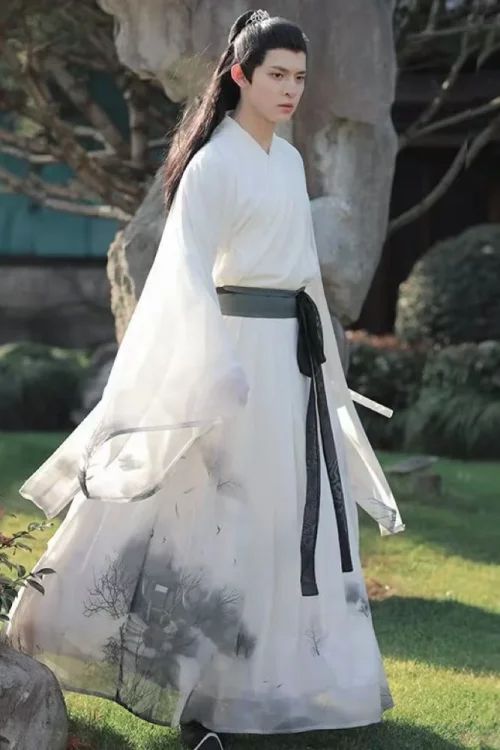汉服: A Symbol of Chinese Heritage and Identity
Men’s Hanfu, the traditional attire of Chinese men, transcends mere fashion trends and holds profound cultural significance. Rooted in ancient Chinese history, Hanfu embodies the essence of Chinese heritage and identity.

The Zenith of Hanfu in the Han Dynasty
During the Han dynasty, Hanfu reached its zenith, becoming a symbol of cultural refinement and social status. Its intricate designs, flowing fabrics, and elegant silhouettes reflected the sophistication of the era. Over time, Hanfu evolved, adapting to different dynasties and cultural influences, yet retaining its core elements.
Symbolic Meanings of Hanfu
Beyond its aesthetic appeal, Hanfu carries deep symbolic meaning. The right-side closure, known as “youren,” represents the Confucian principle of respecting elders and superiors. The wide sleeves symbolize freedom and unrestrained movement, while the long robes evoke a sense of dignity and grace.
The Contemporary Revival
In contemporary China, there has been a resurgence of interest in Hanfu, particularly among young people. This revival is driven by a desire to reconnect with Chinese cultural roots and to preserve traditional values. Hanfu enthusiasts gather at cultural events, festivals, and online communities to share their passion and promote the appreciation of this ancient attire.
A Bridge to Ancestral Heritage
The cultural significance of men’s Hanfu extends beyond its historical and symbolic value. It serves as a bridge between the past and present, connecting modern Chinese people to their ancestors. By wearing Hanfu, men can express their pride in their heritage and contribute to the preservation of Chinese cultural identity.
Promoting Cultural Exchange
Moreover, Hanfu promotes cultural exchange and understanding. As Chinese culture gains global recognition, Hanfu has become a symbol of China’s rich history and traditions. By showcasing this unique attire, men can share their culture with others and foster cross-cultural dialogue.
结论
In conclusion, men’s Hanfu is not merely a fashion statement but a profound symbol of Chinese heritage and identity. Its intricate designs, symbolic meanings, and cultural significance make it a cherished part of Chinese culture. The revival of Hanfu in contemporary China reflects a deep desire to reconnect with the past and preserve traditional values. As a bridge between the past and present, Hanfu continues to inspire and unite Chinese people, promoting cultural exchange and understanding on a global scale.
The Cultural Significance of Hanfu in Modern Society
The resurgence of Hanfu, the traditional attire of the Han Chinese, has transcended mere fashion trends to become a profound cultural phenomenon. Beyond its aesthetic appeal, Hanfu carries immense historical, cultural, and social significance.

Historical Roots of Hanfu
Historically, Hanfu has been an integral part of Chinese identity for centuries. Its distinct styles and designs reflect the evolution of Chinese civilization, from the flowing robes of the Han dynasty to the elaborate garments of the Tang dynasty. Each dynasty left its unique imprint on Hanfu, shaping its aesthetics and symbolism.
Cultural Values Embedded in Hanfu
Moreover, Hanfu embodies the cultural values and beliefs of the Han Chinese. The intricate embroidery and patterns often depict auspicious symbols, such as dragons, phoenixes, and auspicious clouds, representing prosperity, longevity, and harmony. The colors and fabrics used in Hanfu also hold cultural significance, with red symbolizing joy and celebration, and silk representing elegance and refinement.
Fostering Community and Pride
In modern society, the revival of Hanfu has become a symbol of cultural pride and heritage. It has fostered a sense of community among Han Chinese around the world, connecting them to their shared history and traditions. Hanfu enthusiasts engage in various activities, such as cultural performances, workshops, and online forums, to promote and preserve this ancient art form.
A Platform for Cultural Exchange
Furthermore, Hanfu has become a platform for cultural exchange and dialogue. By showcasing the beauty and diversity of Chinese culture, Hanfu has sparked interest and appreciation among non-Chinese audiences. It has also facilitated cross-cultural collaborations, such as fashion shows and cultural exhibitions, that bridge cultural divides and promote understanding.
结论
The cultural significance of Hanfu extends beyond its historical and aesthetic value. It serves as a tangible link to the past, a symbol of cultural identity, and a catalyst for cultural exchange. As the revival of Hanfu continues to gain momentum, it is poised to play an increasingly important role in shaping the cultural landscape of modern society.
汉服 as a Bridge Between Past and Present
Men’s Hanfu, the traditional attire of Chinese men, transcends mere fashion trends and holds profound cultural significance. It serves as a tangible link between the past and present, embodying the rich heritage and values of Chinese civilization.

Origins and Evolution of Hanfu
Hanfu’s origins can be traced back to ancient times, with its distinct features evolving over centuries. The garments are characterized by their flowing robes, intricate embroidery, and elegant accessories. Each element carries symbolic meaning, reflecting the wearer’s social status, occupation, and personal beliefs.
Preserving Cultural Identity
Beyond its aesthetic appeal, Hanfu plays a vital role in preserving Chinese cultural identity. It embodies the wisdom and craftsmanship of past generations, showcasing the artistry and technical skills that have been passed down through time. By wearing Hanfu, individuals connect with their ancestors and honor the traditions that have shaped their culture.
Fostering Community and Belonging
Moreover, Hanfu fosters a sense of community and belonging. It is often worn during festivals, ceremonies, and cultural events, providing a shared experience that unites people from all walks of life. By participating in these activities, individuals not only celebrate their heritage but also contribute to its preservation and transmission.
The Youthful Revival
In recent years, there has been a resurgence of interest in Hanfu, particularly among young people. This revival is driven by a desire to reconnect with Chinese roots and to express cultural pride. Hanfu enthusiasts engage in various activities, such as studying historical texts, attending workshops, and participating in cultural performances.
结论
The cultural significance of men’s Hanfu extends beyond its historical and aesthetic value. It serves as a bridge between past and present, connecting individuals with their heritage and fostering a sense of community. By embracing Hanfu, men not only make a fashion statement but also contribute to the preservation and transmission of Chinese culture.
